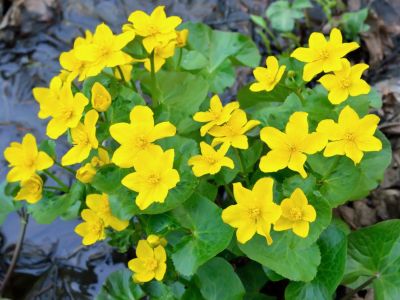What are Marsh Marigolds?
Not related to traditional garden marigolds, the answer is Caltha cowslip, or in botanical terms, Caltha palustris, a member of the Ranunculaceae family. More detail to what are marsh marigolds include the fact that they are herbaceous perennial wildflowers or herbs. Not a traditional herb, however, as leaves and buds of growing marsh marigold plants are poisonous unless they are cooked with several coverings of water. Old-wives tales say they add the yellow color to butter, as they are a favorite of grazing cows. Caltha cowslip is a 1 to 2 foot (31-61 cm.) perennial with a mounding habit and is a succulent. The flower color on growing marsh marigold plants is on sepals, as the plant has no petals. Sepals are borne on waxy and attractive green foliage, which may be heart shaped, kidney shaped, or rounded. A smaller species, the floating marsh marigold (C. natans), grows in more northern areas and has sepals of white or pink. This species has a hollow stem which floats on water. These plants make great additions to the moist garden, and as a bonus Caltha cowslip attracts butterflies and hummingbirds.
How and Where to Grow Marsh Marigolds
Growing marsh marigold plants in moist woodlands and near ponds is simple and marsh marigold care is easy to nonexistent. The Caltha cowslip basically takes care of itself and is suited only to moist areas with well-draining soil. In fact, any moist or boggy area is appropriate for growing marsh marigolds. When you are growing marsh marigold plants, don’t let the soil dry out. They will survive drought conditions but go dormant and lose their leaves. Seeds for propagation of the Caltha cowslip form near the end of the bloom period. These can be collected and should be planted when ripe. Now that you know the ease of marsh marigold care and where to grow marsh marigolds, try adding the Caltha cowslip to a moist area in your woodland or natural area.
